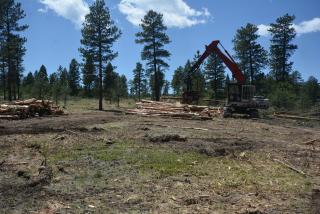Nathan Van Schaik

At a traffic light in the small mountain community of Bailey, Colorado, you can grab a burger and a beer at a local joint. It’s a crossroads of locals and their kids, intermingled with mountain bikers, the occasional tourist, and tired hikers along U.S. Highway 285, one of the most beautiful yet deadly routes through the state. This unincorporated community is quiet, and tranquil, and feels as if time itself slows down.
So, what is it about this western sliver of Jefferson County, near the Pike National Forest that’s got federal, state and city officials turning their heads? And why are so many organizations and agencies investing in this area?
The answer to these questions involves millions of people in the Denver metropolitan area and the water they drink. That’s because a federally funded infrastructure project called Jerome Miller/Miller Gulch seeks to improve forest health and reduce wildfire risks to people, communities, and forest goods and services.
USDA Forest Service employees are working with key partners and communities to complete treatments with funding from the Bipartisan Infrastructure Law. To facilitate funding, the Forest Service established the Wildfire Crisis Strategy to dramatically increase fuels and forest health treatments by up to four times the current treatment levels in the West. Work has begun within high-priority firesheds or landscapes of about 250,000 acres where a fire can start, spread, and threaten communities.
The Jerome Miller/Miller Gulch Project falls on the Colorado Front Range, one of the 10 initial landscapes in eight states to receive funding to confront the wildfire crisis.
So far, 419 acres of the 1,521-acre project area have been completed. The project, which is progressing daily, will support hazardous fuel reductions in fire-prone forests and protect the North Fork of the South Platte River.
The Forest Service, under a stewardship agreement with the non-profit, Stewardship West, will increase the pace and scale of treatments aligned within the Colorado Front Range Priority Landscape. The agreement allows the Forest Service to exchange goods for services, exchange funds for services, or a combination of the two to improve forest health on National Forest System lands for up to 10 years.
“The stewardship agreement is another tool in our toolbox,” explains Ryan Kolling, a Forest Service timber sale coordinator on the Pike-San Isabel National Forests & Cimarron and Comanche National Grasslands. “The agreement benefits not only the Forest Service but also the partner involved and the surrounding communities. Built into the agreement is flexibility.”
For those that live close, and to the millions that live upstream, wildfire is no stranger. The Buffalo Creek Fire and the Hi Meadow Fire both left burn scars visible from this project area. About 10 miles south of here, the Hayman Fire struck in 2002 and was Colorado’s largest fire for 18 years. This is why both Aurora Water and Denver Water have invested in the project.
“This is an area that Denver Water prioritized for a wildfire mitigation investment because the project location is directly upstream of the Strontia Springs Reservoir,” explained Madelene McDonald, a watershed scientist for Denver Water. “About 80% of Denver’s drinking water passes through Strontia Springs Reservoir.”
“The Jerome Miller/Miller Gulch Project fills the gap in areas that have already been treated to lessen the severity of fire,” said Mike McHugh, a senior water resources project manager for Aurora Water. “This project completes a long stretch starting up by Shawnee all the way down County Road 126 to protect the North Fork and the main stem of the South Platte from the introduction of sediment.”
What started as a single stewardship agreement in 2021 between the Forest Service and Stewardship West has taken on a life of its own. Today, the Colorado Department of Natural Resources, Colorado State Forest Service, Jefferson Conservation District, Denver Water and Aurora Water, for example, have each invested in the Jerome Miller/Miller Gulch Project.
The Bipartisan Infrastructure Law provides the Forest Service with new authorities and additional critical funding to address risks from catastrophic wildfire and other disasters, strengthen fire-related infrastructure, make better use of the research tools, and support needed ecosystem and structural improvements that benefit people and wildlife.